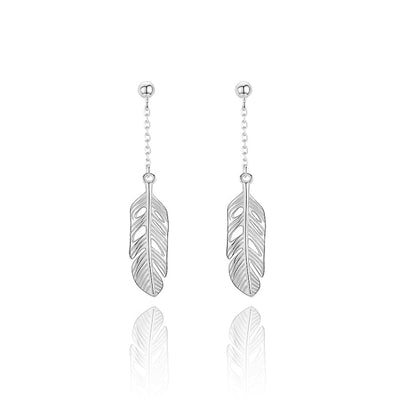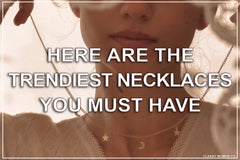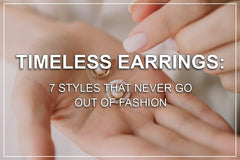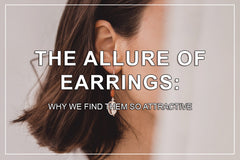The History of Earrings:
From Ancient Times to Modern Day
Earrings are one of the oldest forms of jewelry, and evidence of their use can be traced back to ancient cultures all over the world.
As a beloved form of jewelry for thousands of years, adorning the ears of men and women has been popular from ancient civilizations to the modern day.
From their humble beginnings as simple metal hoops to their evolution into intricately designed pieces of art, the history and origin of the earring is rich and fascinating.
In this article, we delve into the complete known history of earrings, exploring their origins, cultural significance, and evolution through the ages.
Whether you're a jewelry enthusiast or simply curious about the story behind this timeless accessory, join us on a journey through the history of earrings, and discover everything you need to know about these iconic pieces of jewelry.
In this history of earrings roundup, we'll go over the development of earrings in chronological order:
- 10000-2500 BCE: The Birth of the Earring during the Neolithic Period
- 2200-1200 BCE: Earrings in Ancient Egypt
- 1100 BCE - 50 CE: How Ancient Greece and Rome Favored Intricate Earring Designs
- 400-1300 CE: Collapse of the Earring Popularity During the Middle Ages
- 1400-1600: The Rich and Wealthy of the Renaissance Brought Back the Earring
- 1700-1899: Widespread Earring Trends Were Globalized
- 1900-2000: The Era of Statement Earrings and Alternative Materials
- 21st Century: Earrings Remain Popular Across All Genders and Ages
10000-2500 BCE: The birth of the earring
The exact origin of earrings is difficult to pinpoint, as they were likely developed independently in different parts of the world.
However, it is clear that they have been a used form of jewelry for thousands of years and have played an important role in cultures all over the world.
Early evidence
The use of earrings dates back thousands of years, and archaeological evidence suggests that they were worn by humans as early as the Neolithic period.
However, before 2500 BCE, earrings were less common than they would later become.
The first earrings were likely made from simple materials such as bone, shell, or metal and were worn to symbolize status or spiritual significance.
Queen Puabi's tomb
The Mesopotamians were one of the earliest civilizations in history, and their use of earrings is documented in ancient art and literature. Earrings were a popular form of jewelry among Mesopotamians and were often worn as a symbol of wealth and status.
One of the most famous examples of Mesopotamian earrings is the pair of gold hoops worn by Puabi (initially Shu-bad), the queen of Ur, discovered in the Royal Cemetery of Ur in modern-day Iraq. These earrings, which date back to the early dynastic period around 2600-2450 BCE, were made from gold. Queen Puabi's gold hoops are the oldest pair of earrings found to date.

Queen Puabi's earrings, dating back to 2600-2450 BCE, were found in the Royal Tombs of Ur, modern-day Iraq. Photo credit: Penn Museum.
In addition to their aesthetic appeal, earrings in Mesopotamia also appeared to hold spiritual significance. In some cultures, earrings were believed to protect the wearer from evil spirits, while in others, they were used to signify membership in a particular social group or tribe. The use of earrings in Mesopotamia provides a glimpse into this ancient civilization's cultural and artistic achievements.
Ötzi the iceman
One of the earliest examples of earrings comes from the discovery of the mummified body of Ötzi the Iceman, who lived over 5,000 years ago.

Ötzi the iceman's naturally mummified remains at the South Tyrol Museum of Archaeology.
Interestingly, in addition to the over 60 tattoos on his body, Ötzi had pierced holes on his earlobes that were stretched to around 7-10 millimeters in diameter, which were likely achieved through the use of earplugs made from wood, bone, or metal, such as bronze.
The presence of Ötzi's pierced and stretched ears suggests that earrings may have been worn for both aesthetic and cultural reasons in ancient times.
From the early times to today
Although the use of earrings before 2500 BCE is not well-documented, the discovery of Ötzi's pierced ears and queen Puabi's earrings provides valuable insight into the history of this timeless accessory.
As we explore the evolution of earrings throughout history, we can trace the development of this unique form of jewelry from its modest onset to the beautifully designed pieces we see today.
Here are a few popular modern-day earrings inspired by the earliest known earring designs from 10000-2500 BCE era:

Gold thick teardrop hoops – €104.95 EUR

Silver irregular open hoop earrings – €104.95 EUR

Gold mini double twist hoops – €52.95 EUR

Silver large irregular hoops – €99.95 EUR
2200-1200 BCE: Earrings in ancient Egypt
The ancient Egyptians were known for their love of jewelry, and earrings were an important accessory during the period from 2200-1200 BCE.
Based on the hieroglyphs and our current understanding of the culture, ancient Egyptian people were deep believers in the magical powers of jewelry. Because of the widespread belief of the protection, healing, and good luck of jewelry, nearly everyone from the poor to the wealthy wore charms and jewelry on their body.
In addition, there is a wealth of evidence from archaeological discoveries that provide insight into the use of earrings and their importance as an accessory in ancient Egypt.
King Tutankhamun and Queen Nefertiti
King Tutankhamun, the most famous pharaoh of ancient Egypt, did not have pierced ears. Instead, he was believed to have worn earrings as a child, as evidenced by the presence of small depressions in his earlobes. This suggests that earrings were a popular option in ancient Egypt, especially among royalty and wealthy youth.
King Tutankhamun's wife, Queen Nefertiti, is believed to have worn two earrings in each ear. These earrings were likely made from gold and precious stones, and were a symbol of her status and beauty.
Findings point to simplistic hoop-like designs
Archaeological excavations and discoveries in Egypt have yielded a significant number of earrings, providing valuable insights into the fashion and style of this ancient civilization. Many of these earrings were found in tombs, indicating their importance in funerary dress and ritual practices.

Four Ancient Egyptian hoop earrings dating to the start of New Kingdom period 1550-1425 BCE. For context, the largest earring (right) has an inner diameter of 5cm, while the smallest (left) has a 0.9cm inner diameter.
Although the earrings found in ancient Egyptian tombs are often quite minimal in design and highlight the use of penannular and annular hoops, the findings also include simple studs and elaborate dangling earrings with symbolic construction. They were often made from gold, silver, and other precious materials, reflecting the wealth and status of the individual buried in the tomb.

Penannular earrings that remain from the reign of Ahmose-Thutmose III during the eighteenth dynasty (ca. 1500 BCE).
The sheer number and variety of earrings found in ancient Egyptian tombs suggest that they were highly valued and cherished by the individuals who wore them. They provide a tangible link to the past, shedding light on the intricate cultural practices and beliefs of this ancient civilization.
Integrate the fashion of ancient Egyptian Pharaohs' earring designs into your style and be inspired by the 2200-1200 BCE era:

Gold chunky huggie hoops – €87.95 EUR

Wide gold huggie hoops – €89.95 EUR

Purple beaded gold hoops – €74.95 EUR

Large thin gold hoops – €59.95 EUR
1100 BCE - 50 CE: How ancient Greece and Rome favored intricate earring designs
Earrings were an important part of ancient Greek and Roman jewelry, serving as a symbol of social status and beauty.
Although both men and women wore earrings and jewelry, the association with beauty and goddesses made jewelry predominantly utilized by women. In fact, many believed that jewelry was feminine and, therefore, not suitable for men.
As suggested by the uncovered jewelry dating back to ancient Greece, most earrings featured more intricate and sophisticated designs than seen before.

Detailed earrings from ancient Greece's Classical and Hellenistic eras dating 600-400 BCE. For context, the largest earring (right) has a length of 5cm, while the smallest (left) is 2.4cm in size.
Social status and fashion
Throughout ancient Greece and Rome, earrings held a special place in the world of fashion and social status. They were highly prized for their beauty and often made from precious metals like gold, silver, and bronze. Women, in particular, embraced the wearing of earrings, with many intricate and elegant designs created to complement their hairstyles and clothing.

Intricate 1.9cm lion head hoops from Greek Classical or Hellenistic era ca. 300 BCE.
For many women in ancient Greece and Rome, the type of earrings worn was an important indicator of their social status. The wealthiest and most influential women often wore elaborate, ornate earrings adorned with precious stones or gems. Conversely, simpler, more understated earrings were worn by women of lower status, serving as a way to differentiate themselves from their wealthier counterparts.

2.9cm crescent-shaped earrings made by mixing gold and silver. Classical Greek period, ca. 400 BCE.
Cultural and religious significance
Earrings in ancient Greece and Rome were not just a form of personal adornment, but also a reflection of cultural values and beliefs.

Small 1.6cm Electrum earrings with lobes and rosettes from East Greek. Archaic period, 500 BCE.
In Greece, earrings were often worn during religious ceremonies, symbolizing offerings made to the goddess Aphrodite, while in Rome, earrings were believed to provide protection against evil spirits and promote good health.
As an accessory, earrings played a vital role in ancient Greek and Roman culture and fashion. They were often paired with other pieces of jewelry, such as necklaces, bracelets, and rings, to create a cohesive and stylish look. Today, the tradition of wearing earrings continues, with many modern designs inspired by the ornate and intricate styles of ancient Greece and Rome.
Check out these present-day earrings inspired by the designs from ancient Greece between 1200 BCE and 50 CE:

Gold snake huggies – €57.95 EUR

Silver triple twist hoops – €74.95 EUR

Gold & white jade hoops – €154.95 EUR

Large red oval stone drop earrings – €146.95 EUR
400-1300 CE: Collapse of the earring popularity during the middle ages
The designs and materials used for earrings advanced considerably during the middle ages. Earrings were often intricate and ornate, reflecting the craftsmanship and creativity of the era.
Despite the developments in their design, the use of earrings experienced a decline in popularity in some regions like Europe during the middle ages. The decline can be attributed to a variety of factors, including changing fashions, religious and cultural influences, and economic factors.
Although there was a decline in some parts of the world, earrings remained an important accessory for many people.
Earrings in medieval Europe
During the Middle Ages in Europe, the use of earrings saw a decline in popularity among women, likely due to changing fashions, such as the expectation to cover one's hair with veils or hoods.
However, earrings continued to be worn by some individuals, with designs and materials varying depending on social status and cultural influences.

Medieval Italian earrings made from gold. Byzantine or langobardic era ca. 500 CE. For context, the largest earring (right) is 4.5cm in length.
Nobles and royalty often wore elaborate earrings made from precious metals and gemstones, while commoners wore simpler designs made from cheaper materials like brass or pewter. Earrings were also used as symbols of religious and political affiliation, with some Christian groups forbidding their use.
In spite of the general decline in popularity in Europe, earrings remained an important accessory in some regions, particularly in Spain and Italy.
Earrings in the Islamic world
Earrings were widely worn and highly valued in the Islamic world during the Middle Ages. They held religious and cultural significance, notably for women, who often wore them as a sign of their marital status or as part of their everyday attire.

Iranian earrings made from gold wire with filigree and pale stone. Approximately 1100 CE.
Similarly to the current trends, earrings in the Islamic world during the Middle Ages were often designed to be worn in pairs, with matching or complementary designs for each ear.
The popularity of earrings in the Islamic world during the Middle Ages was also reflected in the wider use of jewelry and other accessories, which were often seen as a way to express one's social status, wealth, and personal taste.
Dominance of Asia
With Asia at the forefront of jewelry at the time, earrings were a prominent fashion accessory throughout Asia during the Middle Ages.
In China and Japan, earrings were also worn as a symbol of status and prosperity. Wealthy individuals adorned themselves with elaborate earrings made of jade and other precious materials, while traditional Chinese opera costumes often featured intricate earring designs to reflect the performer's role.

10.5cm long medieval Korean earrings made from gold. 6th century, three kingdoms period.
Korea seemed to have the most advanced earring designs during the middle ages. Both men and women wore earrings in Korea, with designs influenced by the artistic and cultural movements of the time.
Earrings in medieval Korea were worn mostly by the wealthy and nobility, and they were often made from precious metals and repeatedly featured leaves in their design.
Take a look at these earrings that draw inspiration from medieval designs:

Gold purple mosaic drops – €77.95 EUR

Silver feather drop earrings – €44.95 EUR

Gold medieval crystal cross earrings – €89.95 EUR

Silver mini crystal hoops – €47.95 EUR
1400-1600: The rich and wealthy of the renaissance brought back the earring
The Renaissance was a time of great change and development in the world of art, literature, and culture, marked by a renewed interest in classical forms and a celebration of human potential. This period also had a significant impact on the world of fashion and jewelry, including earrings.
Earrings played an important role in expressing the elegance and refinement of the period's fashion, as well as the social status and personal taste of the wearer.
The history of Renaissance jewelry and earrings is also a story of innovation and experimentation, as artisans and designers pushed the boundaries of technique and form to create dazzling works of art.
Prevalence of earrings in European art
Renaissance art often depicted women wearing intricate and decorative earrings, which were typically larger and more ostentatious than those worn in previous eras.

Cropped Italian oil on canvas painting by Lorenzo Lotto. 1565-1570.
For women in Renaissance Europe, earrings were more than just decorative accessories—they were seen more as a symbol of beauty, wealth, and social status.

Cropped Italian oil on canvas painting by Titian. 1520.
Women of all backgrounds sought to adorn themselves with the finest and most fashionable earrings available. Because larger and more complex designs were associated with elevated status and beauty, many women spent more time and resources to jewelry like earrings than ever before.
16th-Century India's unique jewelry style
During the years 1400-1600, India saw a significant influence of Mughal culture on fashion and jewelry.
In India, earrings were one of the most important accessories worn by both men and women. Indian earrings of this time period were often large and ornate, featuring intricate designs.

Pair of intricate 5 x 1.7cm gold earrings from 16th century India.
In Northern India, Jhumkas were particularly popular. Although the origin of Jhumka earrings reach as far as 300 BCE, it wasn't until 1400 the design really started gaining ground. These were bell-shaped earrings that often featured pearls or beads hanging from them. They were typically worn by women with traditional Indian attire, such as sarees and salwar kameez.
The intricate designs used in Indian and European earrings during the 15th and 17th century period continue to inspire contemporary jewelry designers to this day.
For Renaissance fans, these earrings draw their inspiration from the 16th century and are available today:

Gold teardrop crystal mini chandelier earrings – €78.95 EUR

Double pearl drop stud earrings – €72.95 EUR

Gold purple crystal flower drop chain earrings – €134.95 EUR

Multicolor triple pearl drop earrings – €87.95 EUR
1700-1899: Widespread earring trends were globalized
Led by the innovation during the Reneissance, the 1700-1899 period continued to see earrings commonly worn as a symbol of wealth and status. The designs were also heavily impacted by the Renaissance, often made from precious metals and adorned with precious gems like diamonds, rubies, and pearls.
Unlike during the past several centuries, earrings in the 18-19th century were popular among both men and women, and were often worn in pairs.
From large and heavy to small and delicate
In the 18th century, earrings were often large and heavy, with designs that included hoops, drops, and chandeliers.

Pair of 4.4cm long gold drop earrings with amethyst drops and embellishment from ca. 1830.
The popularity of earrings continued to grow in the 19th century, and new materials such as enamel and glass were incorporated into their design. The use of earrings also became more widespread, as they were no longer reserved for the upper classes but were worn by people from all walks of life.
During the latter half of the 19th century, the use of earrings became more modest, with smaller and more delicate designs that were easier to wear. This was in part due to changing fashions, but also reflected a shift in attitudes towards modesty and restraint.

Pair of small earrings made from jet (lignite) gemstone from 1880's America.
Despite many cultural collisions and wars around the world, earrings remained a popular form of jewelry throughout the 1700-1899 period, and continued to evolve and adapt to changing fashion trends and cultural influences.
Here are a few earrings you can use today to bring an authentic 19th-century vibe into your style:

Gold purple crystal huggie teardrop earrings – €59.95 EUR

Blue crystal pavé flower studs – €108.95 EUR

Silver teardrop crystal threader earrings – €54.95 EUR

Pink crystal floral studs – €54.95 EUR
1900-2000: The era of statement earrings and alternative materials
In the 20th century, earrings underwent many changes in style and design, reflecting the societal shifts of the time.
As was in the late 1800s, during the early part of the 20th century, earrings were often simple and understated, with small studs or hoops being the most popular styles. As the century progressed, however, earrings became more extensive and ornate, with dangling styles and chandelier earrings gaining popularity in the 1920s and 1930s.
Emphasis on making a good impression via jewelry
During the 1960s and 1970s, earrings became even more expressive, with bold and colorful designs inspired by the psychedelic and hippie movements.
Hoop earrings also regained traction during this time, often worn in multiples and sometimes paired with other jewelry such as nose rings and bracelets.
In the 1980s and 1990s, earrings continued to be an important fashion accessory, with statement styles such as shoulder dusters and ear cuffs becoming popular.
Find some inspiration from the 1900s and style yourself with these gorgeous earrings:

Shooting star chandelier earrings – €114.95 EUR

Gold chunky crystal huggie hoop earrings – €134.95 EUR

Large heart shaped hoop earrings – €44.95 EUR

Gold triple baguette bar drop hoop earrings – €104.95 EUR
21st Century: Earrings remain popular across all genders and ages
Today, earrings remain a beloved form of jewelry, with a wide variety of styles and designs available to suit any taste or occasion.
The use of earrings has evolved throughout history, from simple adornments to precision-crafted metal and gemstone designs, and today's earrings reflect the diversity and creativity of contemporary fashion.
In many cultures, earrings continue to hold deep cultural and spiritual significance and are worn as a symbol of identity or faith. They are also a popular gift, with many people giving and receiving earrings on special occasions such as birthdays, weddings, and holidays.
From simple hoops to elaborate chandeliers, earrings have come a long way from their humble origins and continue to be a cherished and truly timeless accessory.
Our extensive selection of women's earrings serves the ones looking to add a touch of elegance to their outfits. Here's a glimpse into our offering:

5mm gold zirconia studs – €37.95 EUR

Gold turquoise smiley emoji hoops – €59.95 EUR

Gold scorpion hoop earrings – €76.95 EUR

Gold green mini marquise hoop earrings – €72.95 EUR
Big thanks to the Metropolitan Museum of Art for its wide selection of open-access data regarding historical artifacts and jewelry.
For now, thanks for reading and participating in this visual experience traveling through time, and learning about the history of earrings.







